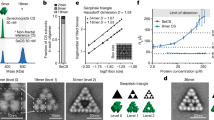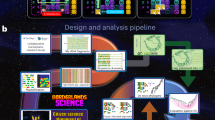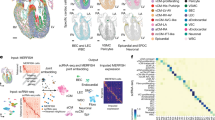Abstract
Previous simulations of the growth of cosmic structures have broadly reproduced the ‘cosmic web’ of galaxies that we see in the Universe, but failed to create a mixed population of elliptical and spiral galaxies, because of numerical inaccuracies and incomplete physical models. Moreover, they were unable to track the small-scale evolution of gas and stars to the present epoch within a representative portion of the Universe. Here we report a simulation that starts 12 million years after the Big Bang, and traces 13 billion years of cosmic evolution with 12 billion resolution elements in a cube of 106.5 megaparsecs a side. It yields a reasonable population of ellipticals and spirals, reproduces the observed distribution of galaxies in clusters and characteristics of hydrogen on large scales, and at the same time matches the ‘metal’ and hydrogen content of galaxies on small scales.
This is a preview of subscription content, access via your institution
Access options
Subscribe to this journal
Receive 51 print issues and online access
$199.00 per year
only $3.90 per issue
Buy this article
- Purchase on Springer Link
- Instant access to full article PDF
Prices may be subject to local taxes which are calculated during checkout





Similar content being viewed by others
References
Planck Collaboration. Planck 2013 results. XVI. Cosmological parameters. Preprint at http://arxiv.org/abs/1303.5076 (2013)
Katz, N. Dissipational galaxy formation. II — Effects of star formation. Astrophys. J. 391, 502–517 (1992)
Schaye, J. et al. The physics driving the cosmic star formation history. Mon. Not. R. Astron. Soc. 402, 1536–1560 (2010)
Brook, C. B., Stinson, G., Gibson, B. K., Wadsley, J. & Quinn, T. MaGICC discs: matching observed galaxy relationships over a wide stellar mass range. Mon. Not. R. Astron. Soc. 424, 1275–1283 (2012)
Springel, V. E pur si muove: Galilean-invariant cosmological hydrodynamical simulations on a moving mesh. Mon. Not. R. Astron. Soc. 401, 791–851 (2010)
Moustakas, J. et al. PRIMUS: Constraints on star formation quenching and galaxy merging, and the evolution of the stellar mass function from z = 0–1. Astrophys. J. 767, 50 (2013)
Navarro, J. F. & Steinmetz, M. Dark halo and disk galaxy scaling laws in hierarchical universes. Astrophys. J. 538, 477–488 (2000)
Scannapieco, C. et al. The Aquila comparison project: the effects of feedback and numerical methods on simulations of galaxy formation. Mon. Not. R. Astron. Soc. 423, 1726–1749 (2012)
Illingworth, G. D. et al. The HST eXtreme Deep Field (XDF): combining all ACS and WFC3/IR data on the HUDF region into the deepest field ever. Astrophys. J. Suppl. Ser. 209, 6 (2013)
Moore, B. et al. Dark matter substructure within galactic halos. Astrophys. J. 524, L19–L22 (1999)
Boylan-Kolchin, M., Bullock, J. S. & Kaplinghat, M. Too big to fail? The puzzling darkness of massive Milky Way subhaloes. Mon. Not. R. Astron. Soc. 415, L40–L44 (2011)
Hansen, S. M. et al. Measurement of galaxy cluster sizes, radial profiles, and luminosity functions from SDSS photometric data. Astrophys. J. 633, 122–137 (2005)
Budzynski, J. M., Koposov, S. E., McCarthy, I. G., McGee, S. L. & Belokurov, V. The radial distribution of galaxies in groups and clusters. Mon. Not. R. Astron. Soc. 423, 104–121 (2012)
Quilis, V. & Trujillo, I. Satellites around massive galaxies since z∼2: confronting the millennium simulation with observations. Astrophys. J. 752, L19 (2012)
Tal, T. et al. Galaxy environments over cosmic time: the non-evolving radial galaxy distributions around massive galaxies since z = 1.6. Astrophys. J. 769, 31 (2013)
Nagai, D. & Kravtsov, A. V. The radial distribution of galaxies in Λ cold dark matter clusters. Astrophys. J. 618, 557–568 (2005)
Saro, A. et al. Properties of the galaxy population in hydrodynamical simulations of clusters. Mon. Not. R. Astron. Soc. 373, 397–410 (2006)
Libeskind, N. I., Cole, S., Frenk, C. S., Okamoto, T. & Jenkins, A. Satellite systems around galaxies in hydrodynamic simulations. Mon. Not. R. Astron. Soc. 374, 16–28 (2007)
Hansen, S. M., Sheldon, E. S., Wechsler, R. H. & Koester, B. P. The galaxy content of SDSS clusters and groups. Astrophys. J. 699, 1333–1353 (2009)
Cortese, L., Catinella, B., Boissier, S., Boselli, A. & Heinis, S. The effect of the environment on the H I scaling relations. Mon. Not. R. Astron. Soc. 415, 1797–1806 (2011)
Davé, R. & Oppenheimer, B. D. The enrichment history of baryons in the Universe. Mon. Not. R. Astron. Soc. 374, 427–435 (2007)
Wiersma, R. P. C., Schaye, J. & Theuns, T. The effect of variations in the input physics on the cosmic distribution of metals predicted by simulations. Mon. Not. R. Astron. Soc. 415, 353–371 (2011)
Gallazzi, A., Brinchmann, J., Charlot, S. & White, S. D. M. A census of metals and baryons in stars in the local Universe. Mon. Not. R. Astron. Soc. 383, 1439–1458 (2008)
Gallazzi, A., Charlot, S., Brinchmann, J., White, S. D. M. & Tremonti, C. A. The ages and metallicities of galaxies in the local universe. Mon. Not. R. Astron. Soc. 362, 41–58 (2005)
Woo, J., Courteau, S. & Dekel, A. Scaling relations and the fundamental line of the local group dwarf galaxies. Mon. Not. R. Astron. Soc. 390, 1453–1469 (2008)
Kirby, E. N. et al. The universal stellar mass-stellar metallicity relation for dwarf galaxies. Astrophys. J. 779, 102 (2013)
Noterdaeme, P., Petitjean, P., Ledoux, C. & Srianand, R. Evolution of the cosmological mass density of neutral gas from Sloan Digital Sky Survey II – Data Release 7. Astron. Astrophys. 505, 1087–1098 (2009)
Zafar, T. et al. The ESO UVES advanced data products quasar sample. II. Cosmological evolution of the neutral gas mass density. Astron. Astrophys. 556, A141 (2013)
Hernquist, L., Katz, N., Weinberg, D. H. & Miralda-Escudé, J. The Lyman-alpha forest in the cold dark matter model. Astrophys. J. 457, L51 (1996)
Pontzen, A. et al. Damped Lyman α systems in galaxy formation simulations. Mon. Not. R. Astron. Soc. 390, 1349–1371 (2008)
Altay, G., Theuns, T., Schaye, J., Booth, C. M. & Dalla Vecchia, C. The impact of different physical processes on the statistics of Lyman-limit and damped Lyman α absorbers. Mon. Not. R. Astron. Soc. 436, 2689–2707 (2013)
Rafelski, M., Wolfe, A. M., Prochaska, J. X., Neeleman, M. & Mendez, A. J. Metallicity evolution of damped Lyα systems out to z∼5. Astrophys. J. 755, 89 (2012)
Fumagalli, M. et al. Absorption-line systems in simulated galaxies fed by cold streams. Mon. Not. R. Astron. Soc. 418, 1796–1821 (2011)
Cen, R. The nature of damped Lyα systems and their hosts in the standard cold dark matter universe. Astrophys. J. 748, 121 (2012)
Bregman, J. N. The search for the missing baryons at low redshift. Annu. Rev. Astron. Astrophys. 45, 221–259 (2007)
Huterer, D. & Takada, M. Calibrating the nonlinear matter power spectrum: requirements for future weak lensing surveys. Astropart. Phys. 23, 369–376 (2005)
Laureijs, R. et al. Euclid assessment study report for the ESA cosmic visions. Preprint at http://arxiv.org/abs/0912.0914 (2009)
van Daalen, M. P., Schaye, J., Booth, C. M. & Dalla Vecchia, C. The effects of galaxy formation on the matter power spectrum: a challenge for precision cosmology. Mon. Not. R. Astron. Soc. 415, 3649–3665 (2011)
Smith, R. E. et al. Stable clustering, the halo model and non-linear cosmological power spectra. Mon. Not. R. Astron. Soc. 341, 1311–1332 (2003)
Takahashi, R., Sato, M., Nishimichi, T., Taruya, A. & Oguri, M. Revising the Halofit model for the nonlinear matter power spectrum. Astrophys. J. 761, 152 (2012)
Weinmann, S. M. et al. A fundamental problem in our understanding of low-mass galaxy evolution. Mon. Not. R. Astron. Soc. 426, 2797–2812 (2012)
Hopkins, P. F. et al. Galaxies on FIRE (Feedback In Realistic Environments): stellar feedback explains cosmologically inefficient star formation. Preprint at http://arxiv.org/abs/1311.2073 (2013)
Vogelsberger, M. et al. A model for cosmological simulations of galaxy formation physics. Mon. Not. R. Astron. Soc. 436, 3031–3067 (2013)
Dolag, K., Borgani, S., Murante, G. & Springel, V. Substructures in hydrodynamical cluster simulations. Mon. Not. R. Astron. Soc. 399, 497–514 (2009)
Springel, V., White, S. D. M., Tormen, G. & Kauffmann, G. Populating a cluster of galaxies — I. Results at z = 0. Mon. Not. R. Astron. Soc. 328, 726–750 (2001)
Huang, S., Haynes, M. P., Giovanelli, R. & Brinchmann, J. The Arecibo Legacy Fast ALFA Survey: the galaxy population detected by ALFALFA. Astrophys. J. 756, 113 (2012)
Prochaska, J. X., O’Meara, J. M. & Worseck, G. A definitive survey for Lyman limit systems at z ∼ 3.5 with the Sloan Digital Sky Survey. Astrophys. J. 718, 392–416 (2010)
Vogelsberger, M., Sijacki, D., Kereš, D., Springel, V. & Hernquist, L. Moving mesh cosmology: numerical techniques and global statistics. Mon. Not. R. Astron. Soc. 425, 3024–3057 (2012)
Sijacki, D., Vogelsberger, M., Kereš, D., Springel, V. & Hernquist, L. Moving mesh cosmology: the hydrodynamics of galaxy formation. Mon. Not. R. Astron. Soc. 424, 2999–3027 (2012)
Kereš, D., Vogelsberger, M., Sijacki, D., Springel, V. & Hernquist, L. Moving-mesh cosmology: characteristics of galaxies and haloes. Mon. Not. R. Astron. Soc. 425, 2027–2048 (2012)
Genel, S. et al. Following the flow: tracer particles in astrophysical fluid simulations. Mon. Not. R. Astron. Soc. 435, 1426–1442 (2013)
Torrey, P., Vogelsberger, M., Sijacki, D., Springel, V. & Hernquist, L. Moving-mesh cosmology: properties of gas discs. Mon. Not. R. Astron. Soc. 427, 2224–2238 (2012)
Xu, G. A new parallel N-body gravity solver: TPM. Astrophys. J. Suppl. Ser. 98, 355 (1995)
Barnes, J. & Hut, P. A hierarchical O(N log N) force-calculation algorithm. Nature 324, 446–449 (1986)
Faucher-Giguère, C.-A., Lidz, A., Zaldarriaga, M. & Hernquist, L. A new calculation of the ionizing background spectrum and the effects of He II reionization. Astrophys. J. 703, 1416–1443 (2009)
Ferland, G. J. et al. CLOUDY 90: numerical simulation of plasmas and their spectra. Publ. Astron. Soc. Pacif. 110, 761–778 (1998)
Rahmati, A., Pawlik, A. H., Raicevic, M. & Schaye, J. On the evolution of the H I column density distribution in cosmological simulations. Mon. Not. R. Astron. Soc. 430, 2427–2445 (2013)
Kennicutt, R. C., Jr The star formation law in galactic disks. Astrophys. J. 344, 685–703 (1989)
Chabrier, G. Galactic stellar and substellar initial mass function. Publ. Astron. Soc. Pacif. 115, 763–795 (2003)
Springel, V. & Hernquist, L. Cosmological smoothed particle hydrodynamics simulations: a hybrid multiphase model for star formation. Mon. Not. R. Astron. Soc. 339, 289–311 (2003)
Zahid, H. J. et al. Empirical constraints for the magnitude and composition of galactic winds. Astrophys. Space Sci. 349, 873–879 (2014)
Di Matteo, T., Springel, V. & Hernquist, L. Energy input from quasars regulates the growth and activity of black holes and their host galaxies. Nature 433, 604–607 (2005)
Sijacki, D., Springel, V., Di Matteo, T. & Hernquist, L. A unified model for AGN feedback in cosmological simulations of structure formation. Mon. Not. R. Astron. Soc. 380, 877–900 (2007)
Marinacci, F., Pakmor, R. & Springel, V. The formation of disc galaxies in high-resolution moving-mesh cosmological simulations. Mon. Not. R. Astron. Soc. 437, 1750–1775 (2014)
Seljak, U. & Zaldarriaga, M. A line-of-sight integration approach to cosmic microwave background anisotropies. Astrophys. J. 469, 437 (1996)
Lewis, A. & Challinor, A. CAMB: Code for Anisotropies in the Microwave Background. Astrophysics Source Code Library http://asterisk.apod.com/wp/ (2011)
Hinshaw, G. et al. Nine-year Wilkinson Microwave Anisotropy Probe (WMAP) observations: cosmological parameter results. Astrophys. J. Suppl. Ser. 208, 19 (2013)
Spergel, D., Flauger, R. & Hlozek, R. Planck data reconsidered. Preprint at http://arxiv.org/abs/1312.3313 (2013)
White, S. D. M. in Cosmology and Large Scale Structure (eds Schaeffer, R., Silk, J., Spiro, M. & Zinn-Justin, J. ) 349 (Elsevier, 1996)
Zel’dovich, Y. B. Gravitational instability: an approximate theory for large density perturbations. Astron. Astrophys. 5, 84–89 (1970)
Seager, S., Sasselov, D. D. & Scott, D. A new calculation of the recombination epoch. Astrophys. J. 523, L1–L5 (1999)
Seager, S., Sasselov, D. D. & Scott, D. RECFAST: Calculate the Recombination History of the Universe. Astrophysics Source Code Library http://asterisk.apod.com/wp/ (2011)
Davis, M., Efstathiou, G., Frenk, C. S. & White, S. D. M. The evolution of large-scale structure in a universe dominated by cold dark matter. Astrophys. J. 292, 371–394 (1985)
Bruzual, G. & Charlot, S. Stellar population synthesis at the resolution of 2003. Mon. Not. R. Astron. Soc. 344, 1000–1028 (2003)
Lupton, R. et al. Preparing red-green-blue images from CCD data. Publ. Astron. Soc. Pacif. 116, 133–137 (2004)
Acknowledgements
V.S. acknowledges support from the DFG Research Centre SFB-881 ‘The Milky Way System’ through project A1, and from the European Research Council under ERC-StG EXAGAL-308037. G.S. acknowledges support from the HST grants programme, no. HST-AR-12856.01-A. Support for program no. 12856 was provided by NASA through a grant from the Space Telescope Science Institute, which is operated by the Association of Universities for Research in Astronomy, Inc., under NASA contract NAS 5-26555. L.H. acknowledges support from NASA grant NNX12AC67G and NSF grant AST-1312095. D.X. acknowledges support from the Alexander von Humboldt Foundation. S.B. was supported by NSF grant AST-0907969. The Illustris simulation was run on the CURIE supercomputer at CEA/France as part of PRACE project RA0844, and the SuperMUC computer at the Leibniz Computing Centre, Germany, as part of GCS-project pr85je. Further simulations were run on the Harvard Odyssey and CfA/ITC clusters, the Ranger and Stampede supercomputers at the Texas Advanced Computing Center through XSEDE, and the Kraken supercomputer at Oak Rridge National Laboratory through XSEDE. Figure 1b is based on observations made with the NASA/ESA Hubble Space Telescope. These data were obtained from the Mikulski Archive for Space Telescopes (MAST) at the Space Telescope Science Institute (STScI). These observations were associated with programs 9,352, 9,425, 9,488, 9,575, 9,793, 9,978, 10,086, 10,189, 10,258, 10,340, 10,530, 11,359, 11,563, 12,060, 12,061, 12,062, 12,099 and 12,177, and compiled for the Hubble eXtreme Deep Field data release version 1.0 (http://archive.stsci.edu/prepds/xdf/). Support for MAST for non-HST data is provided by the NASA Office of Space Science via grant NNX13AC07G and by other grants and contracts.
Author information
Authors and Affiliations
Contributions
M.V., L.H., D.S., V.S. and S.G. conceived and planned the project. M.V., S.G., D.S. and P.T. developed the galaxy formation model. V.S. developed the AREPO code. M.V. generated initial conditions. V.S., M.V. and S.G. ran the simulations. M.V. performed the main analysis. G.S. and P.T. constructed the mock images. S.B. provided statistics of the inter-galactic medium. D.X. and D.N. provided post-processing tools. M.V., S.G., V.S., P.T. and L.H. interpreted the results. M.V. and S.G. wrote the manuscript with contributions from co-authors.
Corresponding author
Ethics declarations
Competing interests
The authors declare no competing financial interests.
Rights and permissions
About this article
Cite this article
Vogelsberger, M., Genel, S., Springel, V. et al. Properties of galaxies reproduced by a hydrodynamic simulation. Nature 509, 177–182 (2014). https://doi.org/10.1038/nature13316
Received:
Accepted:
Published:
Issue Date:
DOI: https://doi.org/10.1038/nature13316
This article is cited by
-
Dark matter substructures affect dark matter-electron scattering in xenon-based direct detection experiments
Journal of High Energy Physics (2023)
-
Electromagnetic counterparts to massive black-hole mergers
Living Reviews in Relativity (2022)
-
Quiescent ultra-diffuse galaxies in the field originating from backsplash orbits
Nature Astronomy (2021)
-
A [C ii] 158 μm emitter associated with an O i absorber at the end of the reionization epoch
Nature Astronomy (2021)
-
The case of the missing satellites
Synthese (2021)
Comments
By submitting a comment you agree to abide by our Terms and Community Guidelines. If you find something abusive or that does not comply with our terms or guidelines please flag it as inappropriate.



